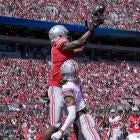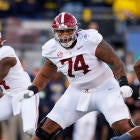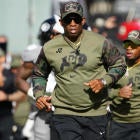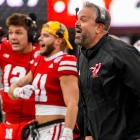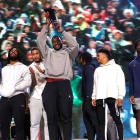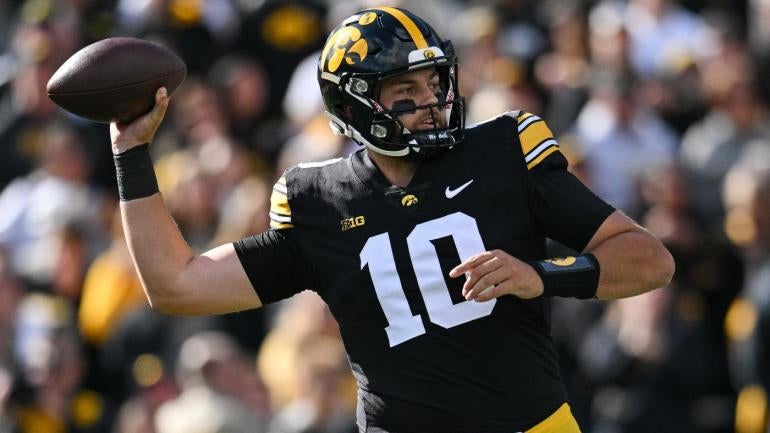
We pause this offensive revolution for a rebuttal from the other side of the ball. Not only was scoring down again across college football at the FBS level in 2023, it was down for the third consecutive year. That has never happened previously since the NCAA started tracking statistics in 1937.
Behold a revealing statistical wrap for 2023:
- Average scoring was down to 27.78 points per team, lowest since 2009.
- Total offense was down for the fifth consecutive year (385.70 yards), lowest since 2010.
- Average yards passing (229.55) were the lowest since 2010, average yards rushing (156.15) the lowest since 2009 and average touchdowns per game (3.47) the lowest since 2008.
"That's a wild stat that you just said," responded Heisman Trophy winning quarterback Jayden Daniels of LSU upon learning of the trends. "There were times we were putting up 50 points, 40 points. It didn't really seem like scoring was [down]."
LSU led the nation in scoring, yet at 45.5 points per game, it posted the lowing scoring average for the top team in that category since Houston in 2009 (42.2 points). It was the second time in five seasons that the Tigers led the country in scoring with a Heisman winner leading the charge.
Something is happening. The question: Why?
- The new first-down rule eliminated a handful of plays from the game.
- Elite defensive linemen have become more important because, for the most part, offensive linemen are losing that battle in the trenches.
- Defenses are simply getting smarter and more varied.
"If you look at all the numbers in both the NFL and college football, points per game is down, yardage is down. No question," Chip Kelly said recently while he was still UCLA's head coach. "Because I think football is cyclical. That's the beauty of the game. It's not always going to be one way."
The 2023 numbers continue to interrupt what was a 30-year trend. From 1993 to 2002 scoring increased each year, and the top 10 scoring seasons have all occurred since 2012. However, since the all-time high of 30.08 points per game in 2016, scoring is down 7.6%. Since 2020, when teams averaged 29.18 points, scoring has declined by 4.8%.
UCLA was part of that trend going from 87th in total defense to 10th last season. The Bruins moved from allowing 29.0 points per game in 2022 to 18.4 in 2023.
"A bunch of it was a lot of our players were a year older," Kelly added. "We had a bunch of Year 2 guys that were transfers who had a really good understanding. That's just part of it. There's an ebb and a flow to it."
Michigan plowed to a national championship with a defense-first philosophy. In fact, a year after TCU made it to the College Football Playoff National Championship with the worst defense in the BCS/CFP era since 1998 (95th in total defense), Michigan won the whole shebang with the nation's No. 1 unit.
Georgia captured the two prior national titles with, respectively, the No. 1 and No. 5 scoring defenses in 2021 and 2022. That 2021 unit that gave up 10.2 points per game, standing as the stingiest since Alabama gave up 8.2 points in 2011. Michigan in 2023 came in right behind those 2021 Bulldogs at 10.4 points.
Road trippin'
We've been conditioned to believe that the new, extended road trips in the new, extended conferences are a minor readjustment from realignment. Yeah, well, maybe.
CBS Sports crunched the numbers on schools most impacted by increased football travel. In case you've forgotten, the Big Ten and ACC are now coast-to-coast leagues.
Turns out the best perspective might be global. Literally. The distance around Earth at the equator is 24,901 miles. These programs in their new conferences will come closest to that number in combined round trip air miles.
We'll let others judge the impact. For now these are the top seven longest-traveling teams in those leagues.
- UCLA -- 22,275 miles (89.4% of the way around the world): Non-conference roundtrips to Hawaii (more than 5,000 miles) and LSU (3,200) inflate this figure, but in their first Big Ten season, the Bruins will also travel to Nebraska, Penn State, Rutgers and Washington. This mileage total is almost five times more than the 2022 UCLA schedule. It also works out to an average road trip from Los Angeles to Montgomery, Alabama.
- California -- 20,886 (83.9%): There are four trips of at least 4,200 miles from the Bay Area and back. That includes games at Wake Forest (4,800 miles), Pittsburgh (4,508), Florida State (4,446) and Auburn (4,204).
- Stanford -- 17,938 (72%): The move to the ACC preserved the traditional rivalry with Cal. The Cardinal travel the 40 miles to Berkeley this season. However, roundtrips to Syracuse (4,880 miles) NC State (4,800) and Clemson (4,446) leave plenty of time for in-air tutoring.
- Washington -- 16,790 (67.4%): In the Big Ten's unbalanced nine-game schedule, the Huskies play five conference road games. Four of those five involve round trips of at least 3,000 miles (Iowa, Penn State, Rutgers and Indiana).
- USC -- 13,356 (53.6%): Trips to Maryland, Michigan and Minnesota account for 85% of the mileage.
- Oregon -- 12,560 (50.4%): The Ducks' longest roundtrips are both at least 3,700 miles to Michigan and Purdue. The Civil War (44 miles away at Oregon State) will be played in September.
- Miami -- 12,226 (49.2%): This figure is fueled by one of the longest trips in the country, 2,868 miles one-way (5,736 total) to Cal on Oct. 5.
Hawaii typically leads the country in miles flown. The Warriors will travel 29,752 miles this year, an average roundtrip of almost 6,000 miles.
Final word on the first-down rule
If you didn't notice the impact of the first-down rule, that might be proof it worked.
The new rule that changed one of the game's most fundamental tenets (in place since 1968) resulted in approximately 4.5 fewer plays per game, according to NCAA secretary rules editor Steve Shaw.
That's actually below projection, which was that seven plays per game would be lost if the clock was allowed to run after first downs. Previously, the first-down rule was the biggest differentiator between college football and the NFL. In the first season they played by the same rule, it was hardly noticeable.
"If you watched the game, and we lost four or five plays per games, no way you knew it," Shaw told CBS Sports. "The feedback is very positive on the clock changes. We'll let it soak another year."
Game times also shrunk an average of 5 minutes per game to 3 hours, 23 seconds. Although that wasn't the primary intent of the rule change -- it was mostly a health and safety measure -- improved efficiency was an appreciated bonus.
Entering the 2023 season, about a quarter of games were lasting more than 3.5 hours. In 2023, that ratio shrunk to about 14%, according to Shaw. Next up may be an alteration that would allow the clock to run after out-of-bounds rushes.
"There's an underlying [feeling] among the commissioners that, over time, they don't think that was enough plays of the game [taken out], especially as we go to the 12-team playoff," Shaw said. "But I think everybody wants to let it [go for a while]."
Hot seats (from a stastical point of view)
- Billy Napier, Florida: The Gators gave up 4.84 per rush in 2023, their most since at least 1989. Napier fired two defensive assistants, including his defensive line coach, and lost another to a promotion at Texas A&M.
- Sam Pittman, Arkansas: New offensive coordinator/old head coach Bobby Petrino guided Texas A&M to its highest-scoring season since 2018. Well, that's if you believe Petrino was ever allowed to fully guide the offense. Jimbo Fisher was fired Nov. 12.
- Dave Aranda, Baylor: 9-16 the last two seasons led to massive changes to the defensive coaching staff. (That's supposed to be Aranda's strength.)
- Clark Lea, Vanderbilt: It's Vandy, which makes it predictable that it hasn't worked so far for Lea. The best number here might be $300 million. That's how much the school is spending to upgrade the SEC's worst football facilities.
Year of the Running Back
- Quinshon Judkins, the Ole Miss transfer now at Ohio State, is one of the most valuable players of 2024. In the last two seasons, he leads all Power Five runners in yards rushing, yards after contact and forced missed tackles, per Pro Football Focus. His 105 yards per game ranks No. 1 among active career leaders.
- Is there any doubt Ohio State now has the nation's best backfield? Treveyon Henderson returns to join Judkins after averaging 5.9 yards in 2023, second in the Big Ten.
- Oklahoma State's Ollie Gordon II was a 1,000-yard rusher after being hit. Despite getting only 19 carries in the Cowboys' first three games, Gordon had 1,056 of his 1,732 yards after contact. Only Omarion Hampton of North Carolina had more yards after contact (1,072) despite running behind a sub-standard offensive line.
- Michigan's Donovan Edwards will go down as one of the game's all-time greats. Just ask him. Edwards enters 2024 averaging 6.7 yards per rush in the postseason.
“I’ll go down as one of the greatest running backs to play the game. I’ll be up there with Walter Payton and Barry Sanders.”
— Max Chadwick (@MaxChadwickCFB) August 6, 2023
Donovan Edwards doesn’t have high expectations for himself, he has 🐐 expectations.
Interview with @DEdwards__ dropping tomorrow!@UMichFootball x @PFF pic.twitter.com/M5neNb7EPK














